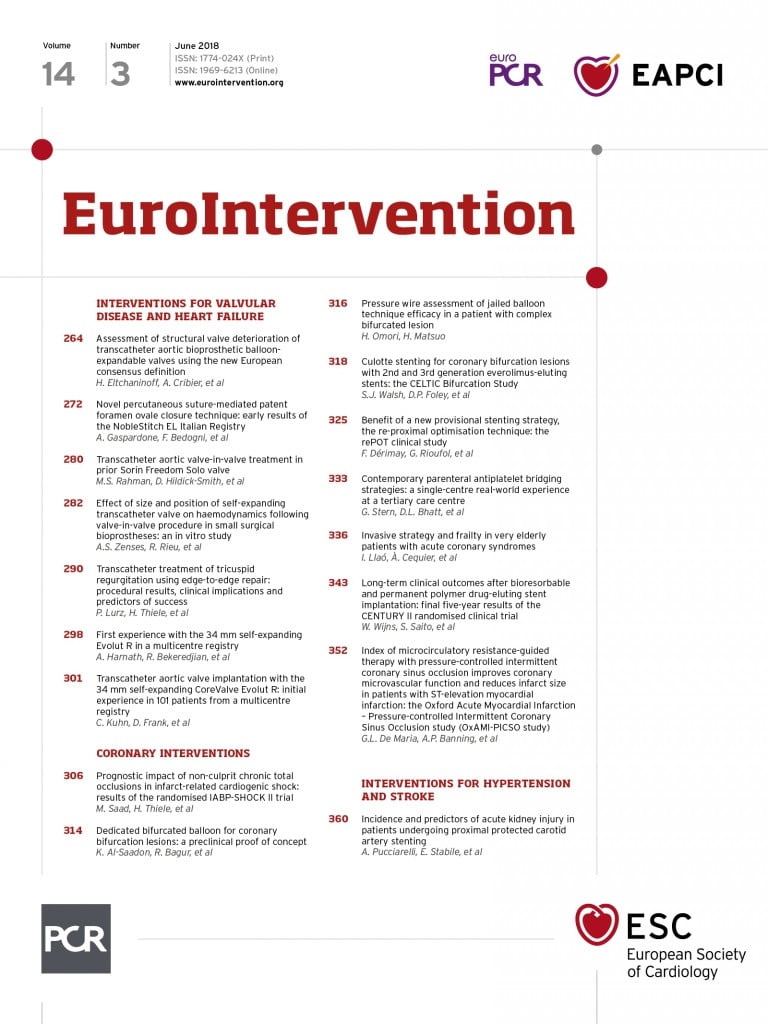
Implementation of guideline-recommended, evidence-based treatment in everyday practice has led to a substantial increase in the quality of delivery of care and significant improvement in the outcomes of cardiac patients1,2. Randomised clinical trials (RCT) are fundamental for evaluating the effectiveness and efficacy of healthcare interventions and therefore the basis of evidence-based medicine. However, not infrequently an efficacy-effectiveness gap largely related to patient selection has been reported3. In trials testing the performance of cardiac devices or cardiovascular drugs, the most frequently reported bias is the one related to sex. Among individuals diagnosed with coronary artery disease, 45% of them are women4, while in device-approval RCTs female patients account for only 25% of total enrollees5. This sex bias is, although less pronounced, still present among patients with acute coronary syndrome. According to AHA/ACC Heart Disease and Stroke Statistics4, 40% of patients discharged with the diagnosis of acute myocardial infarction are women, while female participants in RCTs testing new cardiovascular drugs or devices make up less than 30% of the total study cohort6,7. Furthermore, about 40% of regulatory approval trials do report sex-specific data, while less than one third of them do not even report the sex of enrollees8.
This policy has many consequences for female patients. First, there is the use of high-risk devices and drug prescription in women without having adequate evidence. This is based on the lack of statistical power related to the small number of women enrolled. Second is the inadequate evaluation of drug dosages and their adverse event profile. Pharmacodynamics and pharmacokinetics of drugs differ between sexes, which results in more adverse events among women related to drug overdose. Third is the report of greater than expected sex-specific benefit or harm of a certain device or drug, related to overinterpretation of apparent differences in subgroup analysis and the existing publication bias.
Compared to men, women with symptomatic coronary artery disease are five to 10 years older and present with a greater comorbidity burden. Although no interaction between age and efficacy of percutaneous coronary intervention (PCI) has been observed, many of the pivotal RCTs testing new devices have age cut-offs which discriminate against women in terms of participation in those trials. The higher risk for spontaneous and procedural bleeding complications among women is another justification for exclusion.
Meanwhile, the community has reacted in order to change this situation by performing either prospective registries or RCTs exclusively for women. The PLATINUM Diversity study, a single-arm study focused on women and minorities, terminated enrolment earlier than planned due to faster than predicted patient recruitment. A patient-level pooling with the PROMUS Element Plus Post-Approval Study was pre-specified. The proportion of women undergoing PCI in this analysis was 45%. Although not randomised, its findings highlight the lack of sex-specific differences in stent-driven outcomes9. In the SPIRIT Women randomised trial, 455 women were assigned to either an early-generation drug-eluting stent (DES) or a second-generation everolimus-eluting DES. Published about 10 years after its initial conception, the study confirmed the findings of nearly all other RCTs, demonstrating better performance of second-generation DES over early-generation DES even in women10. Another example is the SAFE-PCI for Women trial, which reported that transradial catheterisation and PCI was associated with lower bleeding risk compared to the transfemoral strategy11. Again, results are fully in line with all other studies investigating bleeding avoidance strategies which enrolled mostly men12.
Although very important for testing devices and strategies in a population perceived to be a minority in the PCI trials, these types of women-dedicated trial are time- and cost-demanding and might further delay implementation of novel treatment options among women. Furthermore, these strategies do not address the key problems leading to sex bias in cardiovascular research – use of age limits and performing excessive confounder cleansing. Although nearly 40% of over 75-year-old patients are treated with cardiovascular drugs, only 10% of them participate in trials for drug approval13. The majority of the older old patients suffering from coronary artery disease are women. Therefore, a policy of avoiding chronological age as gate-keeper in the recruitment process would ensure enrolment of a more representative patient population in approval RCTs. An example of this policy is RCTs in the field of structural heart disease. The proportion of women enrolled in registries and RCTs comparing surgical and transcatheter aortic valve repair strategies ranges between 42% and 60%. Enrolment of patients in these studies depends on the patients’ operative risk independent of their age. Although more progressive in design, the common feature of RCTs in the coronary and structural field is the use of a “male-dominated pattern” in patient profiling. The WIN-TAVI registry, which enrolled only women undergoing transcatheter aortic valve implantation (TAVI), was the very first one to explore the impact of female-sex specific factors on outcome after TAVI14. Of interest was the finding that women with a history of pregnancy were at lower risk of death or stroke at one year after TAVI compared to women who had never been pregnant. Larger populations are required to assess whether this finding is a play of chance, a surrogate for other psychosocial factors or a true biological effect persisting even at older age. This clearly highlights the necessity of incorporating sex-specific questions for better characterisation of populations included in clinical trials.
Nowadays and in the not too distant future, as a consequence of demographic change and population ageing, it is (and will be) necessary to avoid unjustified chronologic age limits in clinical research in order to guarantee enrolment of a representative population including women. Characterisation of a study population by gathering information on sex-specific features is mandatory for understanding better the impact of sex as a biological variable on disease presentation, treatment effect and outcomes. Consequently, only the integration of a both-sexes investigation policy across the whole spectrum of biomedicine will contribute to avoiding sex bias in research and will have an impact on patient care.
Conflict of interest statement
J. Mehilli declares receiving lecture fees from Abbott Vascular, Biotronik, Boston Scientific, Edwards Lifesciences, BMS, and Terumo, and institutional grants from Abbott Vascular and Edwards Lifesciences.

